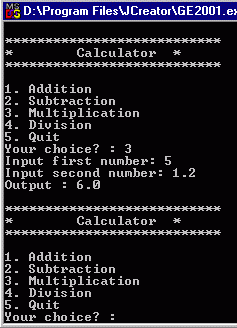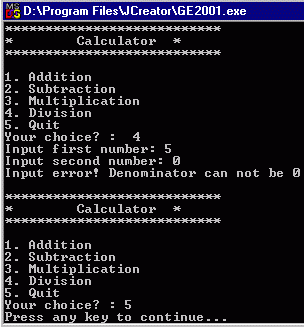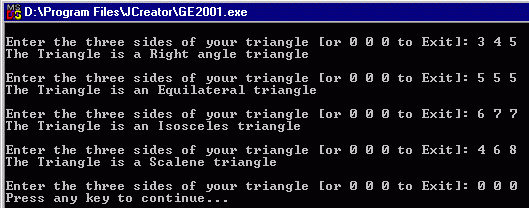INFORMATION & COMPUTER SCIENCE DEPARTMENT, KFUPM
ICS102, SECTIONS 52, 54 & 55
(001 Semester)
INTRODUCTION TO COMPUTING
LAB #10 Revision of Method definition & Parameter Passing
Instructor: Bashir M. Ghandi
![]()
Objectives:
To review the following concepts
- method definition and method calling
- formal and actual parameters
- void and non-void methods
- class (static) and instant (non-static) members
of a class
- private and public members
Introduce reading input using standard classes (without TextIO class).
1. Review of Method definition and Parameter passing
We shall do this by examining a number of examples. Most of the examples have errors. You are to correct the errors and take note
(in writing) the lesson learnt from each example.
Example 1: Correct the following program.
|
public class Discount1 { public
static void main(String[] args) { double
price = 100.00; discount(price); } public
static void discount(int price) { double
newPrice = price * 0.10; System.out.println("Price
after discount is " + newPrice); } } |
What lesson did you learn from it?:
Example 2: Correct the following program.
|
public class Discount2 { public
static void main(String[] args) { double
price = 100.00; discount(price); } public
static void discount(double price, double rate) { double
newPrice = price * rate; System.out.println("Price
after discount is " + newPrice); } } |
What lesson did you learn from it?:
Example 3: Correct the following program.
|
public class Discount3 { public
static void main(String[] args) { double
price = 100.00; double
rate = 0.2; discount(price,rate); } public
static double discount(double price, double rate) { double
newPrice = price * rate; System.out.println("Price
after discount is " + newPrice); } } |
What lesson did you learn from it?:
Example 4: Correct the following program.
|
public class Discount4 { public
static void main(String[] args) { double
price = 100.00; double
rate = 0.2; int
newPrice; newPrice
= discount(price,rate); System.out.println("Price
after discount is " + newPrice); } public static
double discount(double price, double rate) { double
newPrice = price * rate; return
newPrice; } } |
What lesson did you learn from it?:
Example 5: Correct the following program.
|
public class Discount5 { public
static void main(String[] args) { double
price = 100.00; double
rate = 0.2; double
newPrice; newPrice
= discount(double price, double rate); System.out.println("Price
after discount is " + newPrice); } public
static double discount(price, rate) { double
newPrice = price * rate; return
newPrice; } } |
What lesson did you learn from it?:
Example 6: Correct the following program with out changing
the declaration of n.
|
public class ClassAndObjects1 { int n; static
int m; public
static void main(String[] args) { n
= 10; m
= 20; System.out.println("n
= "+n+" , m = "+m); } } |
What lesson did you learn from it?:
Example 7: Correct the following program without changing
the declaration of n and sum.
|
public class ClassAndObjects2 { int n; static
int m; public
int sum() { return n+m; } public
static void main(String[] args) { n
= 10; m
= 20; System.out.println("n
= "+n+" , m = "+m); System.out.println("The
sum is "+sum()); } } |
What lesson did you learn from it?:
Example 8: Correct the following program without changing
the declarations of n and m.
|
class MyInteger { private
int n; public
int m; } public class PrivateAndPublic { public
static void main(String[] args) {
MyInteger intObject = new MyInteger(); intObject.n
= 10; IntObject.m
= 20; System.out.println("n
= "+intObject.n+" , m = "+intObject.m); } } |
What lesson did you learn from it?:
Example 9: What is the output of the following program?
|
class MyInteger { int
n; int
m; public
MyInteger(int num1, int num2) { n=num1; m=num2; } } public class CanChangePartOfObject{ public
static void main(String[] args) { MyInteger intObject = new MyInteger(10, 20); square(intObject); System.out.println("n
= "+intObject.n+" , m = "+intObject.m); } static
void square(MyInteger object) { object.n = object.n * object.n; object.m = object.m * object.m; } } |
What lesson did you learn from it?:
Example 10: What is the output of the following program?
|
class MyInteger { int
n; int
m; public
MyInteger(int num1, int num2) { n=num1; m=num2; } } public class CannotChangeAllOfObject{ public
static void main(String[] args) { MyInteger intObject = new MyInteger(10,
20); square(intObject); System.out.println("After
calling square method, n = "+intObject.n+" , m =
"+intObject.m); } static
void square(MyInteger object) { object = new MyInteger(100,
400); System.out.println("Inside
square method, n = "+object.n+" , m = "+object.m); } } |
What lesson did you learn from it?:
2. Reading Input using standard classes
We have
been using the TextIO class to simplify reading of input from the console. As explained before, this is not a standard class
(it does not come with JDK). This
means, if you are to take your programs to where there is no TextIO class, they
will not run.
Java
provides a number of classes in the java.io package that can be combined
together to read input.
The
basic classes are:
InputStreamReader: This can be
used to create an object that can be used to read streams (single characters)
from an input stream source (e.g System.in).
e.g. InputStreamReader streamInput = new InputStreamReader(System.in);
The
problem with the above object is that it has only one method read() that
can be used to read only one character at a time.
BufferedReader: This can be used to create an object that
can be used to read a sequence of characters (string) from a stream reader
object.
e.g: InputStreamReader
streamInput = new InputStreamReader(System.in);
BufferedReader stdin = new
BufferedReader(streamInput);
Again the
buffered reader object has only one method readLine() that can be used
to read a string.
This
however, is not a problem since we can convert strings to the appropriate
numeric forms using the parse classes introduced earlier (Integer.parseInt(), Double.parseDouble(), etc.).
Since we
do not really need to access the streamInput object in the above definition, it
is a common practice to combine the two definitions above as follows:
BufferedReader stdin = new
BufferedReader(new InputStreamReader(System.in));
Exceptions:
The read()
method of the InputSreamReader and the readLine() method of the BufferedReader generate
exceptions. Thus, like TextIO, each
time we need to use them, we must be prepared to handle a possible IOException
or throw the exception to the interpreter.
Example
11:
The following example shows how input may be read without using TextIO
class.
|
import java.io.InputStreamReader; import java.io.BufferedReader; import java.io.IOException; public class InputWithoutTextIO { static
BufferedReader stdin = new BufferedReader(new InputStreamReader(System.in)); public
static void main(String[] args)throws IOException { int
intValue; float
floatValue; double
doubleValue; String
string;
System.out.print("Enter a String: "); string =
stdin.readLine();
System.out.print("Enter integer value: "); intValue
= Integer.parseInt(stdin.readLine());
System.out.print("Enter float value: ");
floatValue = Float.parseFloat(stdin.readLine());
System.out.print("Enter double value: ");
doubleValue = Double.parseDouble(stdin.readLine());
System.out.println();
System.out.println(string);
System.out.println(intValue);
System.out.println(floatValue);
System.out.println(doubleValue); } } |
3. Assignment
Modify
the assignments of Lab #7 to so that they will work without using the TextIO
class.
The assignments
are reproduced here for your convenience.
1. Write a program that reads three integer numbers and prints the maximum, the minimum and the average. In addition to the main method which should only reads the input and prints the result, your program should have three other methods whose format is given below:
public static int maximum
(int n1, int n2, int n3)
public
static int minimum (int n1, int n2, int n3)
public
static double average (int n1, int n2, int n3)
2. Write a program that simulates a simple arithmetic calculator, which displays a menu and allows a user to perform addition, subtraction, multiplication and division, as shown by the following sample run. Your program should contain the methods for the different operations:
public static void showMenu()
public static int
getChoice() throws IOException
public static double
add(double op1, double op2)
(similarly for subtract, multiply and divide).
|
|
|
3.
Write a program that
reads the sides of a triangle and determine the type of the triangle. The possibilities are:
|
Right-angle |
square of one side is same as sum of the squares of
the other two sides |
|
Equilateral |
all sides are equal |
|
Isosceles |
two of the sides are equal |
|
Scalene |
no two sides are equal |
You
should have a boolean method to test for each of the above types.
Your program should repeat until 0 0 0 is entered.



